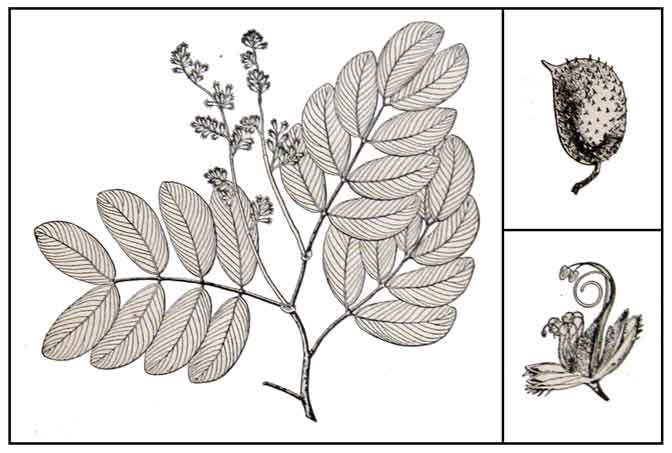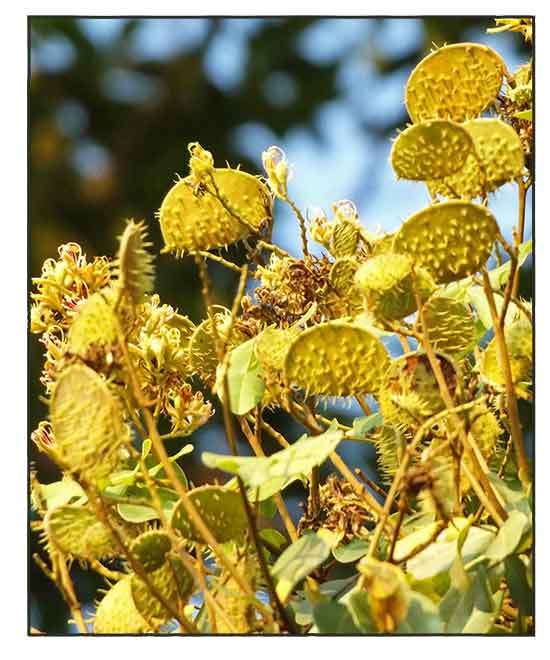
Gen info
• Sindora consists of about 20 species confined to Indo-China and western and central Malesia, except for one species in tropical Africa (Gabon). Sindora inermis and S. supa are found in the Philippines. (7)
 Botany Botany
• Supa is a is a deciduous, unarmed tree reaching a height of 20 to 30 meters. The bole is straight, regular, and without buttresses. Leaves are pinnate, about 15 centimeters long, with three pairs of leaflets which are glabrous, coriaceous, elliptic, 3.5 to 9 centimeters long and 2.5 to 5 centimeters wide. Panicles are terminal or axillary, 10 to 15 centimeters long. Pods are broadly ovate, about 4 centimeters long and 6 centimeters wide, rounded at the base, somewhat beaked at the apex, evenly provided with spinelike thorns. Seeds are 1-3, black, shiny, with a large and fleshy aril.
• Sindora supa is a tree, 15(-30) m tall and 30(-180) cm in diameter. Leaves 2-4-jugate; petiole 1-2.5 cm long, rachis 1-7 cm long; leaflets elliptical, 2-8 cm × 2-4 cm. Inflorescence paniculate, up to 20 cm long; calyx lobes 6-12 mm long; petal sublanceolate, 10-12 mm long; 2 perfect stamens with anthers 3.5 mm long, other anthers much smaller. Fruit broadly ellipsoidal, 4-5 cm × 3-3.5 cm, with straight sharp spines 5 mm long. Seeds 2-4, ovoid, 3 cm × 2 cm, black. (7)
Distribution
- Native to the Philippines.
-
Found in forests at low and medium altitudes in Quezon, Nueva Ecija, Camarines and Albay provinces in Luzon, and in Mindoro. Especially found on limestone ridges in regions with distinct dry season.
- Threatened by habitat loss.
- Classified by the IUCN Red List of Threatened Species as "vulnerable."
(5)
Constituents
- Freshly cut tree yields about 10 liters of oil.
- Oil consists mainly of sesquiterpenes and is soluble in organic solvents except alcohol.
- Wood oil obtained by wasteful method of hacking or cutting cavities in its base. Resin is formed in all depths of the wood which encourages exploiters. (Burkill 1966) (6)
- Tree said to yield 10 liters of oil each.
(6)
Properties
- Oil is non-drying, limpid, light yellow, homogenous, and slightly fluorescent, with a pleasant aromatic odor, and does not become rancid.
- Wood prized for its durability and pleasant aroma.
Parts used
Oil.
Uses
Folkloric
- In the Philippines, supa oil used as external medicine for eczema, herpes, ulcers and other skin diseases.
Others
• Supa oil: Wood oil is light yellow, non-drying, transparent, with specific gravity of 0.9202 and optical rotation of -31.3°. It consists mainly of sesquiterpenes and is soluble in organic solvents except alcohol. A single freshly cut tree of S. supa in the Philippines may yield about 10 liters of wood oil. (7)
• Uses of oil: Tree oil used as illuminant; for caulking boats, making varnishes, paints, transparent paper and adulteration of other oils. (1)
• Energy: Tree has been called the kerosene tree, with an estimate 100 trees per hectare to each yield 10 liters of kerosene/year renewable. (1)
• Wood: Extensive uses for cabinet and furniture making, construction, furniture and interior house trims, general carpentry, naval construction, form work, veneer making, framing. (1) Difficult to work with, it is valued for its durability and pleasant aroma. It is often substituted for the more valuable ipil wood (Intsia bijuga). (8)
Studies
• Effect of Pre-Treatment on Growth Performance of Seedlings: Study investigated the growth performance of seedlings under various pre-treatments viz., hot soaking, cold soaking, mechanical scarification, and control. Results showed 76% of seedlings survived under cold soaking compared with hot soaking (28%) and scarification (24%). Thus, cold soaking treatment improves growth performance of Sindora supa. (7)
Availability
Wild-crafted. |

![]()





